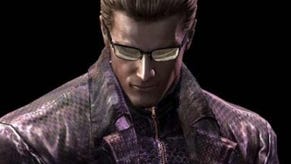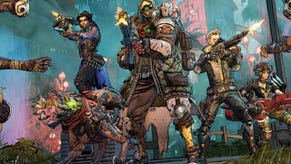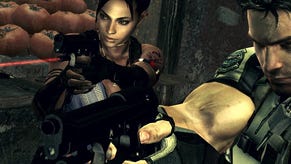Resident Evil 5
Down with the sickness. Chapters 1 to 3 dissected.
You know who the unsung hero of the Resident Evil series is? The guy who moans "Resident Eeeeeevil" at the start of each game. I like to think that it's the same person, and that for each sequel he puts years of practice into making each number sound as spooky as possible.
Loading up a preview build of Resident Evil 5, containing the first three chapters of the game, that booming introduction is one of the few elements still remaining from the traditional template that defined the series throughout the 90s. Following on from Resident Evil 4, this fifth sequel (actually the nineteenth in the series!) is far more action shooter than survival horror, and most of its triumphs and failures stem from trying to serve these two goals at the same time. Much like the bizarre T-virus mutated creatures, this is a series mid-evolution.
Set ten years after the events of the original game, Resident Evil 5 opens with Chris Redfield barrelling through the African savannah on his way to meet with a contact. He's now working for the BSAA, or Bioterrorism Security Assessment Alliance, and is investigating reports that Umbrella's viral weapons have ended up in the hands of African ne'er-do-wells. Arriving in a small town, he's met by Sheva Alomar, his pert and lovely African counterpart from the BSAA and the second playable character for the new co-op based gameplay design.
Chris and Sheva meet with an informant in a butcher's shop, who tells them they need to find a man called Irving. Off you trot into the winding (but linear) slum streets, stepping over mangled animal remains and examining gruesome slaughterhouse leftovers, until you get your first glimpse of the Majini, the Plagas-infected locals who are the African equivalent of Resident Evil 4's Los Ganados. As the first attack wave swarms towards you, there's clearly no chance of fending them off with your limited ammo reserves this early in the game, so you flee to a nearby house and escape through an underground tunnel.
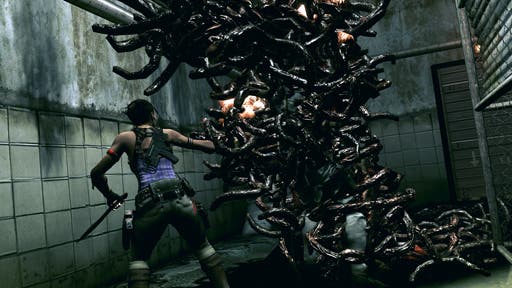
You emerge at the start of a scene that will be familiar to everyone who downloaded the demo. It's the Public Assembly area and things play out exactly as you've seen. You now realise that the man being beheaded is your butcher shop contact, but you're soon fortifying yourself against the next wave of bloodthirsty Majini slaves and the lumbering axe-wielding executioner. The first major action scene of the game, much is familiar from Resident Evil 4. You barricade doors with bookcases, and later kick down ladders to escape their clutches, while exploding barrels and choke points provide carefully placed opportunities to thin the herd.
Playing offline, Sheva falls under AI control and the results are mixed. Assuming she has the items in her inventory, she's able to hand over ammo for the current weapon you're using, heal you when your health is dangerously low, and even combine red and green herbs automatically to create more powerful healing items. However, she's also a bit dim when it comes to combat, and since her death spells game-over even in single-player mode, she can be as much hindrance as help. In the midst of a scrum, the sight of her blithely standing around while the executioner readies his axe right beside her is most unwelcome.
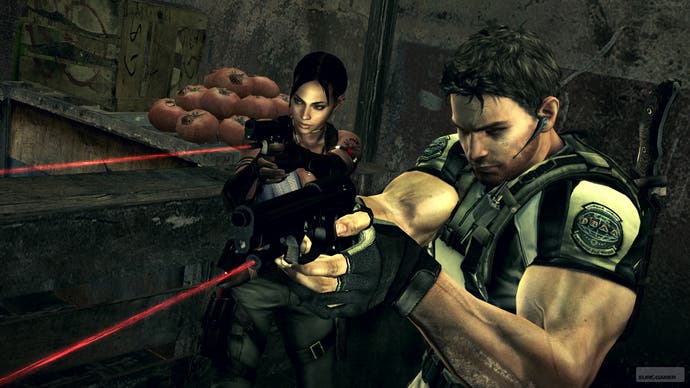
The controls, inevitably, will be the subject of much debate. You can now strafe, and there are four different control set-ups to choose from. Capcom promised "Gears-inspired action controls" but this is a dubious boast. The inability to move and shoot at the same time was originally because of technical limitations, but with the game now an over-the-shoulder co-op shooter more in the style of Army of Two or Kane & Lynch, the decision to stick with the rigid run, fast turn, shoot, repeat approach to combat seems more bloody-minded than creatively inspired. It's not unworkable, and it may be traditional for Resident Evil, but it does leave the game feeling clunky and inelegant in contemporary context. Maybe Capcom needs to have faith that the series has endured for reasons besides the way the characters move.
Chapter 1 continues in this vein, through various streets, houses and buildings, until you reach an underground facility, the location of your first boss encounter. It's a gloopy, wormy mass that takes on a vaguely humanoid shape. It's already polished off another BSAA squad, but luckily for you it decides to attack in a room with a giant incinerator oven at one end. Luring the beast into the oven is the obvious solution, but the timing is tricky since the doors take a while to close, giving the monster a chance to slither back out again if you strike too late.




